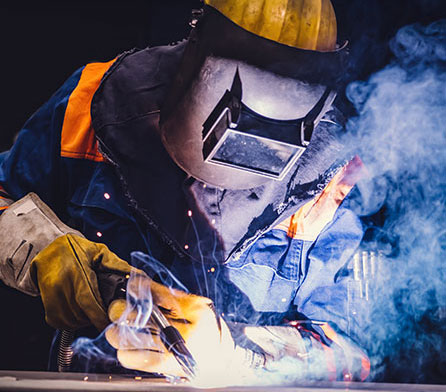Brazing
Brazing joins material by heating it in the presence of a filler metal having a melting point above 840°F (450°C) but below the solidification temperature of the base metal. A variety of processes can provide the heat required for brazing. The filler metal used distributes itself between the closely fitted surfaces of the joint by capillary action. Parts must be properly cleaned in order to achieve a good quality joint. To prevent excessive oxidation during brazing, the parts must be protected by either flux or atmosphere during the heating process. The parts must be designed to provide a capillary for the filler metal when properly aligned, and a heating process must be selected to provide the proper brazing temperature and heat distribution.
The typical brazed joint has a relatively large area and very small gap. In the simplest brazing application, the surfaces to be joined are cleaned to remove contaminants and oxides. Next, they are coated with flux, a material capable of dissolving solid metal oxides and preventing new oxidation. When the joint is heated, the flux melts, cleaning the base metals and protecting them against further oxidation by a layer of liquid.
Brazing filler metal is then melted onto the edge of the joint. Capillary attraction between the base metal and the filler metal is much higher than that between the base metal and the flux, which is displaced by the filler metal. The joint, when cooled to room temperature, will fill with solid filler metal, and the solid flux will be found on the joint periphery.
Why Braze?
- It is economical for complex assemblies
- It is a simple way to connect large joint areas
- It affords excellent stress and heat distribution
- Joints require little or no finishing
- If necessary, brazed joints can be taken apart later
- Coating and claddings can be preserved
- It allows dissimilar and non-metals to be joined to metals
- Precision parts can be joined
- Batch processing allows many parts to be brazed simultaneously
Limitations
- Joint strengths are limited and only suitable in specific applications
- Operator skill requirements are high for manual processes
- Filler metals and labor can be costly, making total expenses high
Brazing Alloys and Fluxes Selection Chart
The melting temperature of the filler metal is greater than 800°F but less than the melting temperature of the base metal. For example: Silver brazing, depending on the alloy, has a range of 1045°F to 1700°F. The alloy bonds the two metals together when flux, alloy and adequate heat are applied to a clean joint with the proper fit-up. Some alloys require 0.001-0.003 gap in the base metals, while some work best with a gap of 0.005. The alloy is drawn into the joint by capillary action. This requires more attention to be paid to fit-up, flux, and heat in order for this process to be successful.
Note: The exception to the flux requirement is Copper-Phosphorus Brazing Alloys. In copper to copper applications, no flux is required but you should back purge the part with nitrogen for an oxide free surface.
| Base Metal 1 | Base Metal 2 | Brazing Alloy | Flux | Temperature | Torch |
|---|---|---|---|---|---|
| Copper | Copper | 15 | None | 1190-1475°F (640-800°C) | Air/FG-2 |
| Copper | Brass | 15 | None | 1190-1475°F (640-800°C) | Air/FG-2 |
| Copper | Steel | A56T | Black | 1145-1205°F (620-650°C) | Oxy/FG-2 |
| Copper | Stainless Steel | 50N | Black | 1290-1375°F (700-750°C) | Oxy/FG-2 |
| Copper | Cast Iron | 50N | White | 1290-1375°F (700-750°C) | Oxy/FG-2 |
| Copper | Tool Steel | 50N | White | 1290-1375°F (700-750°C) | Oxy/FG-2 |
| Brass | Brass | 15 | White | 1190-1475°F (640-800°C) | Air/FG-2 |
| Brass | Steel | A56T | White | 1145-1205°F (620-650°C) | Oxy/FG-2 |
| Brass | Stainless Steel | 50N | Black | 1290-1375°F (700-750°C) | Oxy/FG-2 |
| Brass | Cast Iron | 50N | Black | 1290-1375°F (700-750°C) | Oxy/FG-2 |
| Steel | Steel | 17 Nickel Silver | HW 17 | 1690-1715°F (920-940°C) | Oxy/FG-2 |
| Steel | Stainless Steel | 50N | Black | 1290-1375°F (700-750°C) | Oxy/FG-2 |
| Steel | Cast Iron | 17 Nickel Silver | HW 17 | 1690-1715°F (920-940°C) | Oxy/FG-2 |
| Stainless Steel | Stainless Steel | 50N | Black | 1290-1375°F (700-750°C) | Oxy/FG-2 |
| Stainless Steel | Cast Iron | 50N | Black | 1290-1375°F (700-750°C) | Oxy/FG-2 |
| Cast Iron | Cast Iron | 17 Nickel Silver | HW 17 | 1690-1715°F (920-940°C) | Oxy/FG-2 |





























